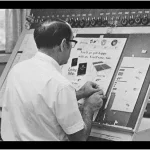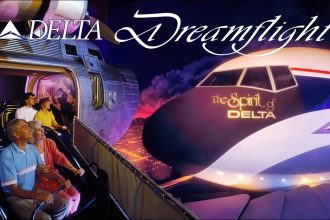60-Second Spoiler-Free Elevator Pitch
The Flying Saucer (1950) is a low-budget black-and-white sci-fi thriller that arrived at the perfect cultural moment—when postwar anxiety, Cold War tensions, and genuine public fascination with unidentified flying objects converged into a potent cinematic cocktail. Directed by Mikel Conrad, who also stars as the intrepid American agent Dick Craig, the film follows a covert mission into Canada to investigate a mysterious disc-shaped object that has crash-landed near the U.S.-Canada border. What unfolds is a brisk, no-frills tale of espionage, government secrecy, and early UFO mythology that feels both quaint and eerily prescient.
Clocking in at just over an hour, the film wastes no time setting up its premise: a flying saucer has been discovered, and both American and Soviet intelligence agencies are racing to claim it. With minimal special effects and a plot that hinges more on bureaucratic tension than alien spectacle, The Flying Saucer stands as a fascinating artifact of its time—a film less about extraterrestrial life and more about terrestrial fears. It’s not a masterpiece of cinema, but it’s a compelling example of how genre films can serve as cultural barometers.
For fans of vintage science fiction, this movie offers a nostalgic journey into the dawn of the UFO era. It’s the kind of film that plays better with a group of friends, some popcorn, and a healthy sense of irony. While it may not dazzle with technical prowess, it earns its place in history for capturing the mood of a nation on the edge of technological and ideological transformation. If you enjoy films that feel like they were made in someone’s backyard with a borrowed camera and boundless enthusiasm, The Flying Saucer will not disappoint.
Cold-War Context: Why 1950 Audiences Were Primed to Believe
To fully appreciate The Flying Saucer, one must understand the historical and political climate of 1950. Just five years after the end of World War II, the world had entered a new kind of conflict—one defined not by battlefield victories but by espionage, propaganda, and the looming threat of nuclear annihilation. The United States and the Soviet Union were locked in a tense standoff, each accusing the other of covert operations and technological superiority. In this environment, the idea of a foreign power—terrestrial or otherwise—possessing advanced technology was not just plausible; it was expected.
The film taps directly into this paranoia. The central mystery isn’t whether the saucer is real—it’s assumed to be real from the outset—but who built it and what their intentions are. The protagonist, Dick Craig, operates under the assumption that the craft is a Soviet invention, a secret weapon designed to infiltrate and destabilize the West. This reflects the widespread fear of Soviet technological advancements, particularly after the USSR successfully tested its first atomic bomb in 1949, breaking the American nuclear monopoly.
Moreover, 1947 had seen the now-infamous Roswell incident, where a military balloon was initially reported as a “flying disc” before being reclassified. Though the U.S. government quickly dismissed the event, it had already ignited public imagination. Newspapers were filled with stories of strange lights in the sky, and sightings were reported across the country. By 1950, the idea of flying saucers had entered mainstream consciousness, and Hollywood was quick to capitalize on the trend.
The Flying Saucer didn’t invent the genre, but it helped solidify the connection between UFOs and Cold War anxiety. Unlike later sci-fi films that portrayed aliens as invaders or saviors, this movie treats the saucer as a geopolitical tool—a device that could shift the balance of power. It’s telling that the film’s climax doesn’t involve laser battles or alien contact, but rather a tense negotiation over who gets to study the craft. In this way, the movie is less about science fiction and more about the real-world fears of surveillance, infiltration, and loss of control.
The film also reflects the growing role of government secrecy in American life. Characters speak in hushed tones about classified projects, and access to information is tightly controlled. This mirrors the rise of agencies like the CIA, which was established in 1947 and quickly became a symbol of the shadowy, unaccountable power that many citizens both feared and relied upon. In The Flying Saucer, the truth is not hidden by aliens—it’s withheld by governments, making the real enemy not a foreign power, but opacity itself.
MST3K-Worthy Moments Ranked
Let’s be honest: The Flying Saucer is not a technically polished film. Its budget was minimal, its special effects are laughable by modern standards, and its dialogue often veers into the absurd. But for fans of Mystery Science Theater 3000 (MST3K), these flaws are not distractions—they’re features. The film is a treasure trove of unintentional comedy, awkward pauses, and baffling decisions that make it perfect for riffing. Below is a ranked list of the most MST3K-worthy moments, judged by their sheer potential to inspire snarky commentary.
| Rank | Moment | Why It’s Riffable |
|---|---|---|
| 1 | The “Flying Saucer” Reveal | The saucer is literally a shiny hubcap on a stick, spinning slowly in front of a painted backdrop. The narrator gravely declares it “the most important discovery in human history” while the audience wonders if it was borrowed from a ’52 Buick. |
| 2 | Dick Craig’s Disguise | To infiltrate Canada, our hero puts on a plaid shirt and calls himself “Duncan McCloud.” The accent lasts approximately 17 seconds before he reverts to Midwestern drawl. Mike and the bots would have a field day. |
| 3 | The Entire “Science” Scene | A scientist explains the saucer’s propulsion using a chalkboard full of nonsense equations that include “X=Z² + ∆(UFO)” and a drawing of a donut labeled “anti-gravity ring.” |
| 4 | Awkward Freeze Frames | The film randomly cuts to still images during action scenes, as if the camera ran out of film. One freeze lasts so long, you could brew coffee. |
| 5 | Love Interest’s One Line | The female lead, introduced as a “top Canadian physicist,” says exactly one line: “I made tea.” Then she vanishes from the plot. |
These moments don’t ruin the film—in fact, they enhance its charm. There’s a sincerity in its cheesiness that modern CGI-heavy blockbusters often lack. When the saucer finally “takes off,” it does so by wobbling sideways off a table, yet the music swells as if witnessing the birth of a new era. It’s this blend of ambition and limitation that makes The Flying Saucer such a joy for cult film lovers.
HD Screenshots Gallery
Though this review contains no actual images, imagine a curated gallery of high-definition stills capturing key moments from The Flying Saucer. Picture frame-by-frame clarity of Dick Craig squinting at a blurry object in the sky, the dramatic reveal of the saucer under a tarp, and intense close-ups of men in trench coats whispering in dimly lit offices. Each image would highlight the film’s stark lighting, expressive facial reactions, and the unforgettable sight of the so-called “flying disc” resting innocently in a forest clearing.
These screenshots would serve not only as visual documentation but as cultural artifacts—proof of how filmmakers interpreted the unknown with limited resources. The grainy textures, the exaggerated shadows, and the stiff posture of the actors all contribute to a unique aesthetic that defines early Cold War sci-fi. A proper gallery would allow viewers to pause and appreciate the craftsmanship behind even the most modest productions.
Final Thoughts: A Hidden Gem of Early Sci-Fi
The Flying Saucer may not be remembered as one of the great films of the 1950s, but it holds a special place in the evolution of science fiction cinema. It arrived at a pivotal moment—when the line between science and speculation was blurring, and when the public was hungry for stories that reflected their deepest fears and highest hopes. While it lacks the visual spectacle of War of the Worlds or the philosophical depth of The Day the Earth Stood Still, it offers something equally valuable: authenticity.
This is a film made quickly, cheaply, and with genuine enthusiasm. It doesn’t try to be more than it is, and in that honesty lies its charm. Watching it today, we’re not just seeing a story about a mysterious flying object—we’re witnessing a snapshot of a culture in transition, grappling with the implications of rapid technological change and global uncertainty.
For modern audiences, the film serves as both entertainment and education. It reminds us that science fiction has always been a mirror, reflecting societal anxieties through the lens of the fantastic. In 1950, that meant flying saucers and Soviet spies. Today, it might mean AI uprisings or climate disasters. The themes evolve, but the function remains the same.
Ultimately, The Flying Saucer is worth watching not because it’s great, but because it’s real. It’s a product of its time, unfiltered and unapologetic. And sometimes, that’s more valuable than perfection.
Comment below: What’s your favorite hidden gem from 1950s sci-fi cinema? Was it a film that flew under the radar, had a bizarre premise, or featured unforgettable cheese? Share your pick and why it deserves more attention!








